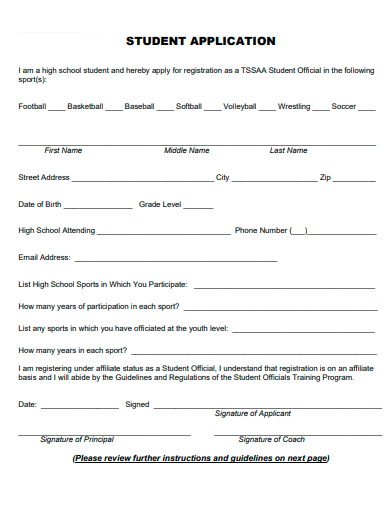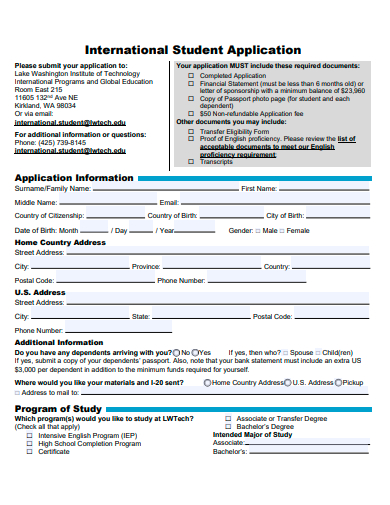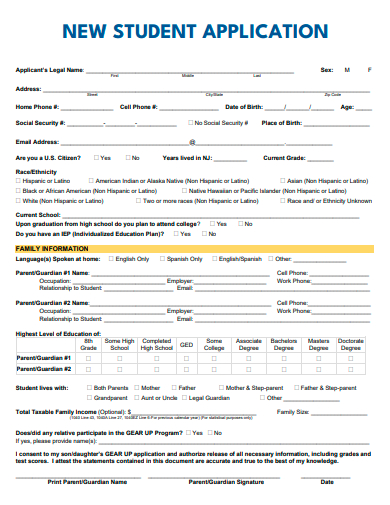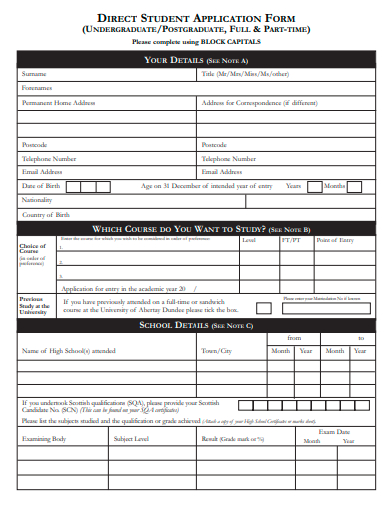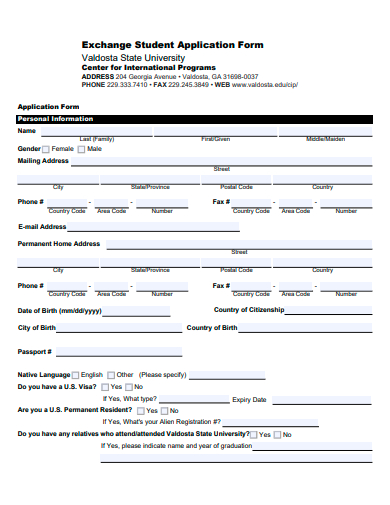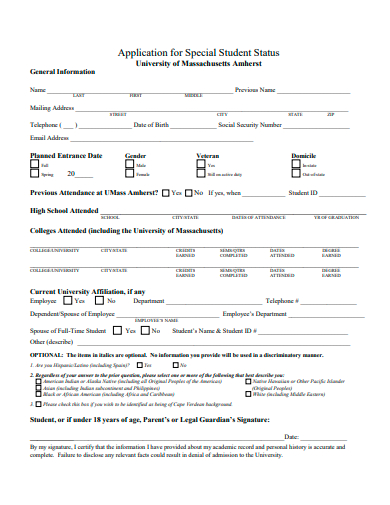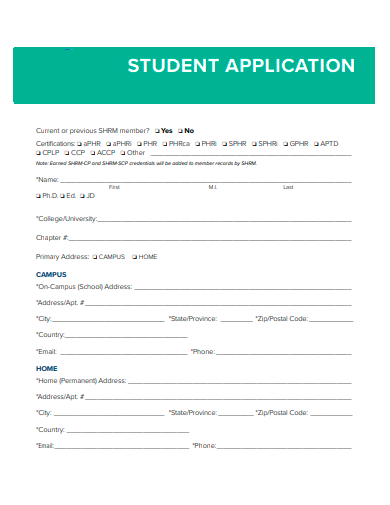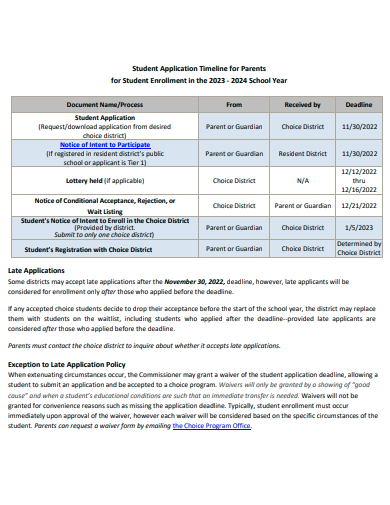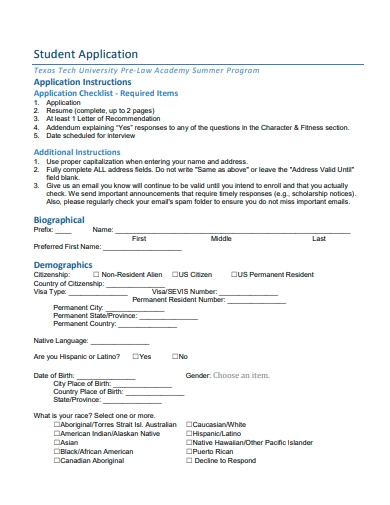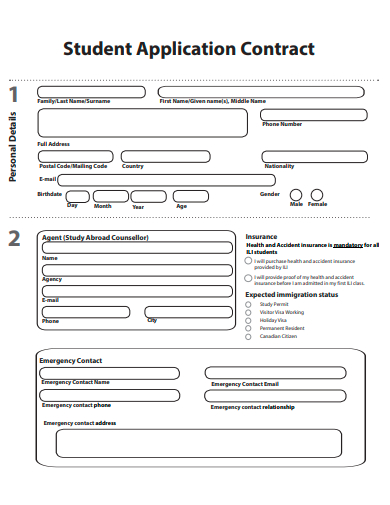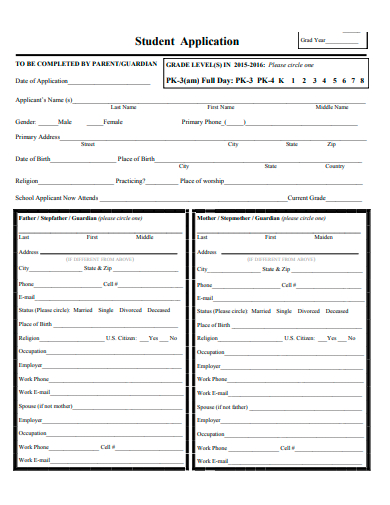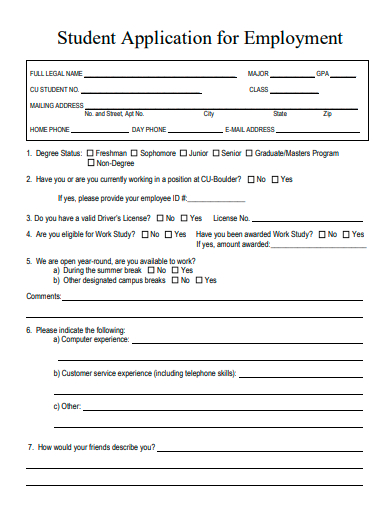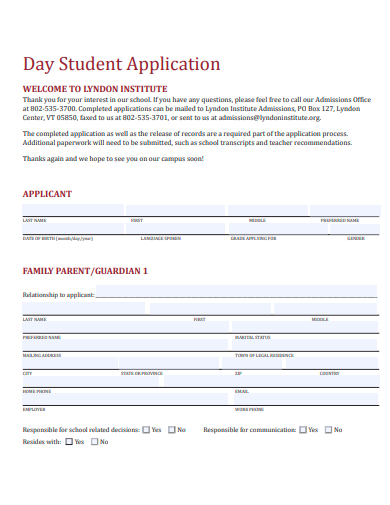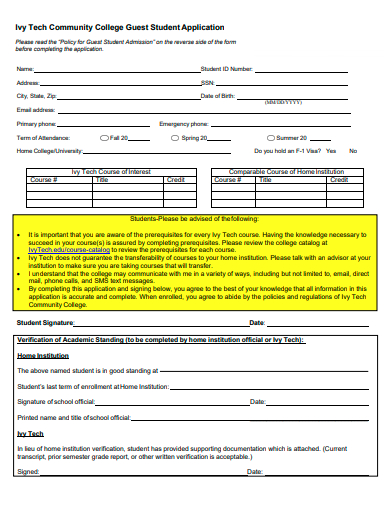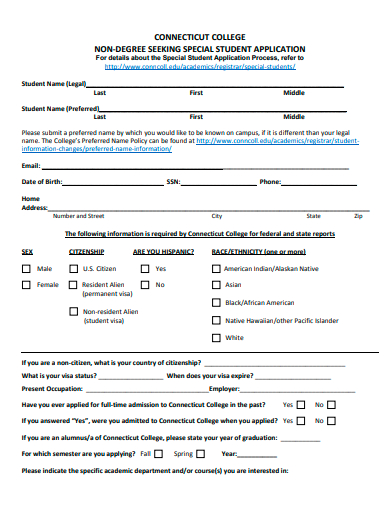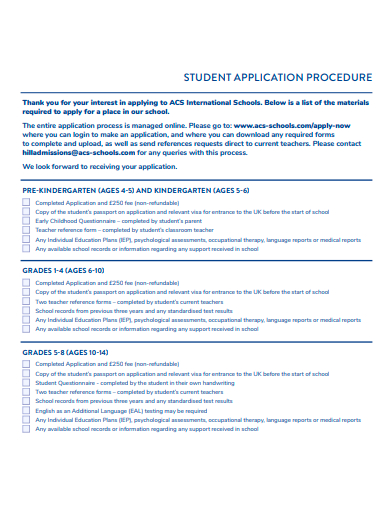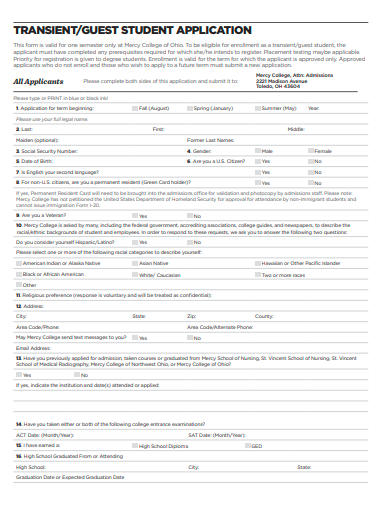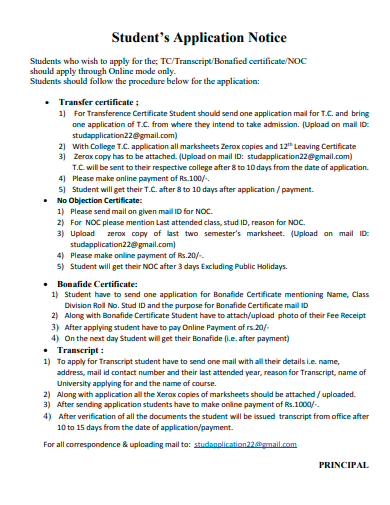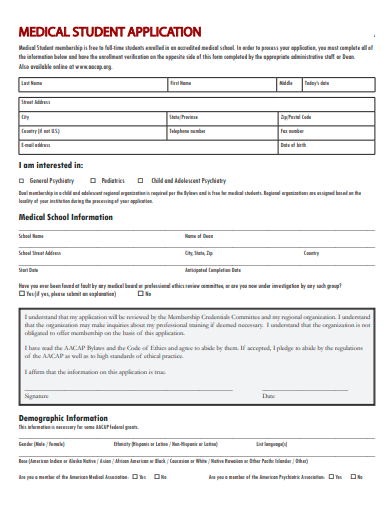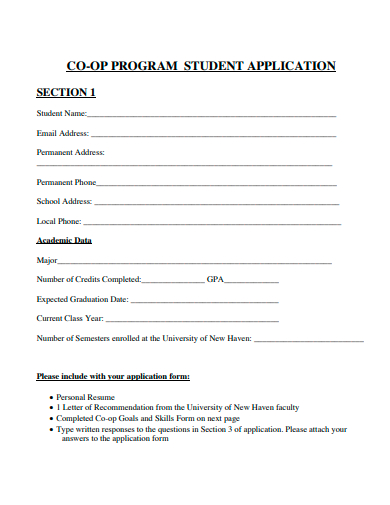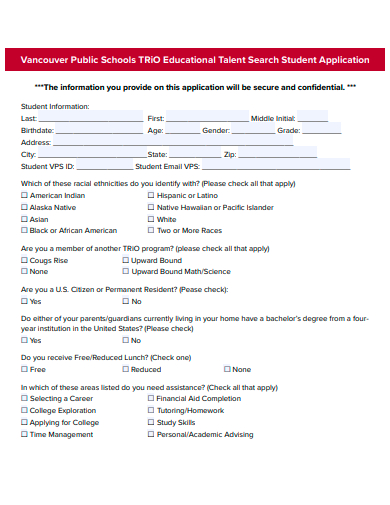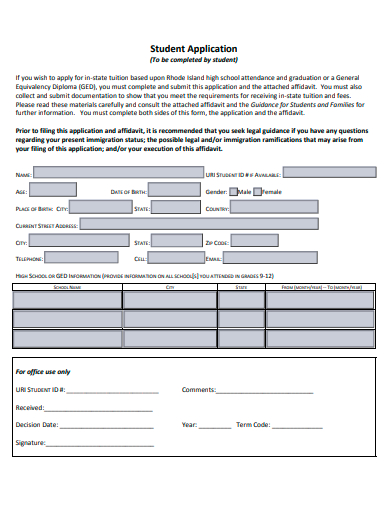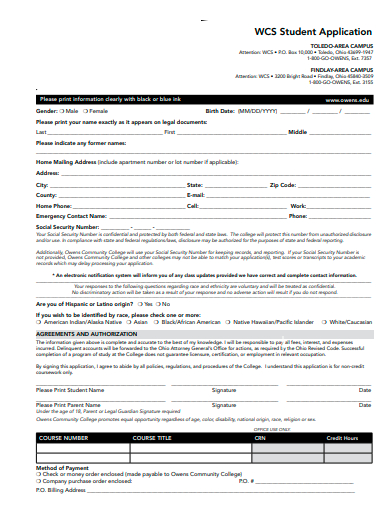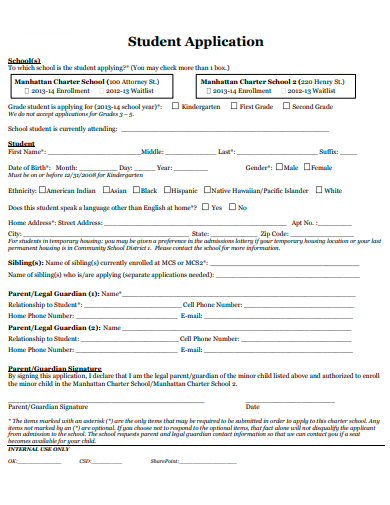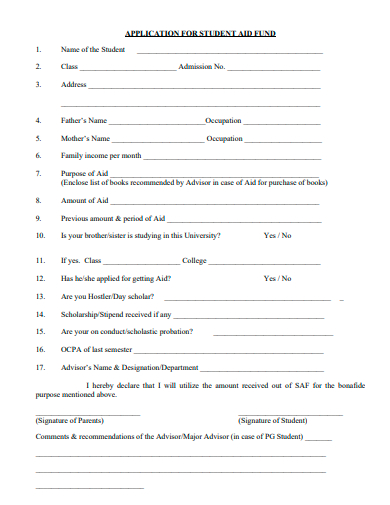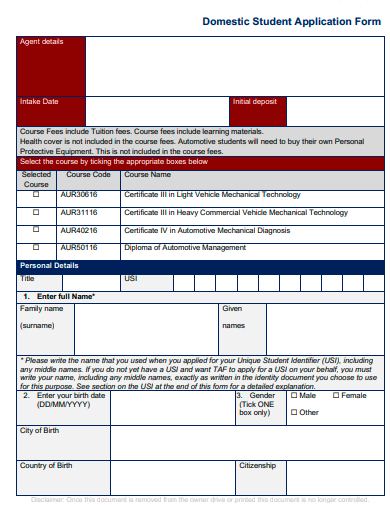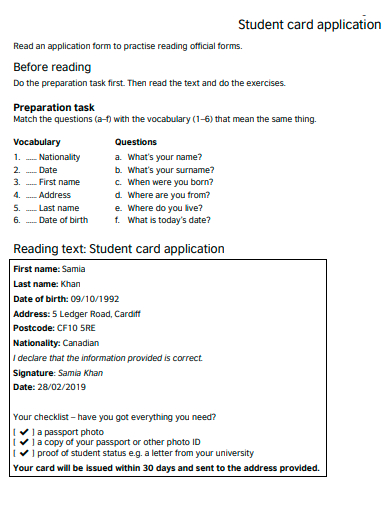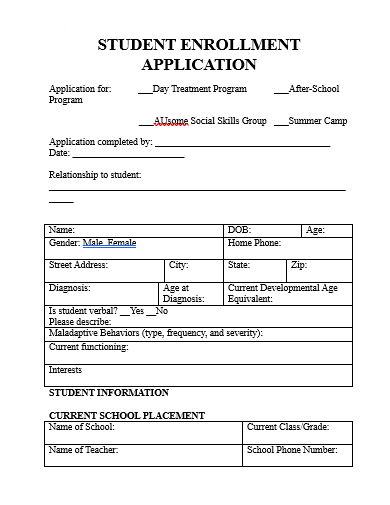Unveiling our Sample Student Application Form Template, an ideal starting point for educational institutions aiming for a flawless admissions process. This template embodies the perfect fusion of comprehensive detail capture and user-centric design. With our Application Form at your fingertips, you’re not just optimizing data collection; you’re elevating the entire student application experience. Dive in and let this resource be the cornerstone of your institution’s digital transformation.
29+ Student Application Form Samples
1. Student Application Template
2. International Student Application Template
3. New Student Application Template
4. Direct Student Application Form Template
5. Visiting Undergraduate Student Application Template
6. Exchange Student Application Form Template
7. Special Student Status Application Template
8. Sample Student Application Template
9. Student Application Timeline for Parents Template
10. Standard Student Application Template
What is a Student Application Form?
At its core, a Student Application Form is a standardized document used by educational institutions to assess and gather essential information about prospective students. This form serves as the initial step in the admission process, allowing institutions to understand an applicant’s academic background, personal details, and other relevant information. However, the importance and components of this form go beyond just these basic details.
Purpose and Significance
The primary purpose of a Student Application Form is to help educational institutions filter and select suitable candidates for their programs. Given the diverse range of applicants that institutions receive every year, this form becomes a crucial tool in distinguishing among them. It provides a snapshot of the applicant’s academic journey, achievements, interests, and even aspirations.
Moreover, this form also allows institutions to ensure that they have all the necessary details to contact the student or their guardian. This becomes particularly important during the later stages of the admission process, such as interviews, entrance tests, or counseling sessions.
Key Components
While the exact components of a Student Application Form can vary based on the institution and the level of education (like undergraduate, postgraduate, or doctoral programs), certain fundamental elements are almost universally present:
- Personal Details: This section captures essential information such as the student’s full name, date of birth, gender, nationality, and contact information.
- Academic Records: Here, students provide details about their previous educational qualifications. This might include grades, percentages, or GPA from schools, colleges, or any other institutions they’ve attended.
- Course Preferences: Applicants specify the course or major they’re interested in. For institutions offering multiple disciplines or specializations, this section helps in directing the application to the relevant department.
- Extracurricular Activities: Institutions often look beyond just academic scores. This section allows students to highlight their achievements in sports, arts, leadership roles, or other non-academic pursuits.
- Personal Statement or Essay: Some forms might include a section where students can write a brief essay or statement explaining their interest in the course, their aspirations, or any other relevant information that might not be captured elsewhere in the form.
- References: Especially common in higher education applications, this section requires details of individuals (like teachers or professionals) who can vouch for the student’s capabilities.
- Photographs and Signature: Most forms will have a provision for attaching a recent photograph and a place for the applicant’s signature, authenticating the information provided.
Digital Evolution
With the advancement of technology, many institutions have transitioned from traditional paper-based application forms to online submission portals. These digital platforms not only make the process more streamlined and environmentally friendly but also facilitate quicker reviews and responses, enhancing the overall efficiency of the admission procedure.
In essence, a Student Application Form is more than just a document; it’s a reflection of a student’s journey, aspirations, and potential. As the first point of formal interaction between the student and the institution, it plays a pivotal role in shaping the future of many young minds. For institutions, it offers a structured way to evaluate and select the next generation of learners, thinkers, and leaders.
11. Student Application Contract Template
12. Printable Student Application Template
13. Student Application for Employment Template
14. Day Student Application Template
15. Community College Guest Student Application Template
16. Special Student Application Template
17. Student Application Procedure Template
18. Guest Student Application Template
19. Student Application Notice Template
20. Medical Student Application Template
21. Program Student Application Template
How to Create a Student Application Form
Creating a student application form is a crucial step for educational institutions. It’s not just about collecting data; it’s about designing a positive first interaction with potential students. A well-structured form can streamline the admissions process, ensuring that institutions gather the necessary information efficiently and applicants find it user-friendly. Here’s a step-by-step guide to creating an effective student application form:
Understand the Purpose
Before diving into the design, it’s essential to understand the form’s objective. Are you catering to undergraduate students, postgraduates, or both? Do you need data for boarding facilities or scholarship eligibility? Clear objectives will guide the form’s content and structure.
Choose the Right Platform
In today’s digital age, paper forms are becoming obsolete. Many institutions are opting for online application platforms that are accessible, efficient, and environmentally friendly. Platforms like Google Forms, Typeform, or proprietary software tailored for educational institutions can be invaluable. Choose a platform that aligns with your institution’s technical capabilities and the expected volume of applications.
Begin with Basic Information
Every application form should start with a section for personal details. This includes the applicant’s full name, date of birth, gender, nationality, and contact information. Depending on the institution’s requirements, you might also need details like passport information, especially for international students.
Integrate Academic Details
Follow the personal details section with an academic information segment. This should cover previous educational institutions, board exams, grades, percentages, and any standardized test scores. If relevant, also provide space for students to upload or input their academic transcripts.
Factor in Course Preferences
Students should be able to indicate their preferred course, major, or specialization. If your institution offers various programs, ensure the form allows for clear and easy selection. For institutions with elective modules, consider adding an optional section for elective preferences.
Incorporate Extracurricular Activities
Modern education values holistic development. Have a segment where students can input their non-academic achievements, be it in sports, arts, community service, or leadership roles. This information can be pivotal for scholarships or specific program selections.
Add Personal Statements or Essay Prompts
A personal statement section allows students to express their motivations for choosing a course or institution. It can also serve as a platform for them to detail any significant life experiences or aspirations.
Request for Recommendations
If your institution requires recommendation letters, include guidelines on how these should be submitted. Some institutions prefer direct uploads, while others might ask for contact details and then reach out to the referees themselves.
Ensure Accessibility and Compliance
If your form is online, ensure it’s mobile-responsive and accessible to individuals with disabilities. Additionally, ensure that your form complies with data protection regulations. Include necessary disclaimers and consent checkboxes.
Test the Form
Before making the form live, test it internally. Check for user-friendliness, ensure all questions are clear, and validate that data gets stored correctly. It might also be beneficial to have a few students pilot the form and provide feedback.
Provide Submission Guidelines
Clearly mention the deadline for form submission. Offer guidelines on any associated fees, necessary documentation, or supplementary materials required. Also, provide a confirmation message or email upon successful form submission to reassure applicants.
In conclusion, a student application form is more than just a data collection tool; it’s the beginning of an educational journey. Taking the time to design it thoughtfully will ensure a smooth admissions process for both the institution and the applicants.
22. Educational Talent Search Student Application Template
23. Formal Student Application Template
24. Visiting Student Application Approval Template
25. Simple Student Application Template
26. Student Application Format
27. Student Fund Application Template
28. Domestic Student Application Form Template
29. Student Card Application Template
30. Student Enrollment Application Template
What is Included in a Student Application Form?
A Student Application Form is more than just a piece of paper or an online formality; it’s the narrative of a student’s academic journey, passions, and aspirations. As the first point of contact between an aspiring student and an educational institution, this document plays a critical role in shaping first impressions and future opportunities.
Personal Information
Every student application form begins with the basics: the student’s full name, gender, date of birth, nationality, and contact information, including email, phone number, and residential address. For younger students, the form might also ask for parent or guardian details to ensure a point of contact.
Academic Background
The heart of the application delves into a student’s academic history. Here, institutions look for the names of previously attended schools or colleges, board examinations taken, academic grades, and any standardized test scores, such as SAT, ACT, or IELTS.
Program Preferences
Depending on the institution’s breadth of offerings, students may need to specify their course, major, or program of interest. This could also involve indicating preferred minors, elective choices, or the desired start date.
Extracurricular Accomplishments
Institutions today value well-rounded students. As such, application forms often have a section dedicated to extracurricular activities. This encompasses sports, arts, leadership roles in clubs, and other noteworthy non-academic achievements.
Personal Essays or Statements
This segment provides insight into a student’s character and motivations. It’s a space where students express their reasons for choosing a specific course, share impactful life experiences, and elucidate how the institution aligns with their future aspirations.
Letters of Recommendation or References
To offer a third-party perspective on the student’s capabilities, many institutions ask for letters of recommendation. These typically come from educators or professionals who can vouch for the student’s potential and character.
Relevant Work or Internship Experience
For advanced or specialized programs, especially at the postgraduate level, detailing past internships, projects, or work experiences can be crucial. It helps institutions gauge the practical skills and industry knowledge of the applicant.
Supplementary Information
A comprehensive application form also seeks information on any disabilities, special needs, or medical conditions to ensure appropriate accommodations. Additionally, students can indicate if they are interested in scholarships or financial aids.
Attestation and Declaration
To ensure authenticity, students must affirm that all provided information is accurate. This section typically culminates with a signature, sealing the student’s formal application submission.
Application Fee and Payment
Lastly, if applicable, students are provided details about the application fee, the acceptable payment methods, and any associated deadlines.
In essence, a Student Application Form is a mosaic of a student’s academic life, personal growth, and aspirations, paving the way for their next educational endeavor.
Related Posts
FREE 20+ University Application Samples in MS Word | Google Docs | PDF
FREE 21+ Administrative Application Samples in MS Word | Apple Pages | PDF
FREE 21+ Teacher Application Samples in MS Word | Apple Pages | Outlook | PDF
FREE 25+ Transfer Application Samples in MS Word | Apple Pages | PDF
FREE 23+ Participation Application Samples in MS Word | PDF
FREE 14+ Patient Application Samples in MS Word | PDF
FREE 21+ Eligibility Application Samples in PDF
FREE 20+ Travel Application Samples in PDF | MS Word
FREE 25+ Sponsor Application Sampales in MS Word | Google Docs | Apple Pages | PDF
FREE 23+ Candidate Application Samples in PDF
FREE 33+ Committee Application Samples in PDF | MS Word
FREE 37+ Supplemental Application Samples in PDF | MS Word
FREE 37+ Product Application Samples in PDF | MS Word
FREE 33+ Visiting Application Samples in PDF | MS Word
FREE 34+ Refund Application Samples in PDF | MS Word

